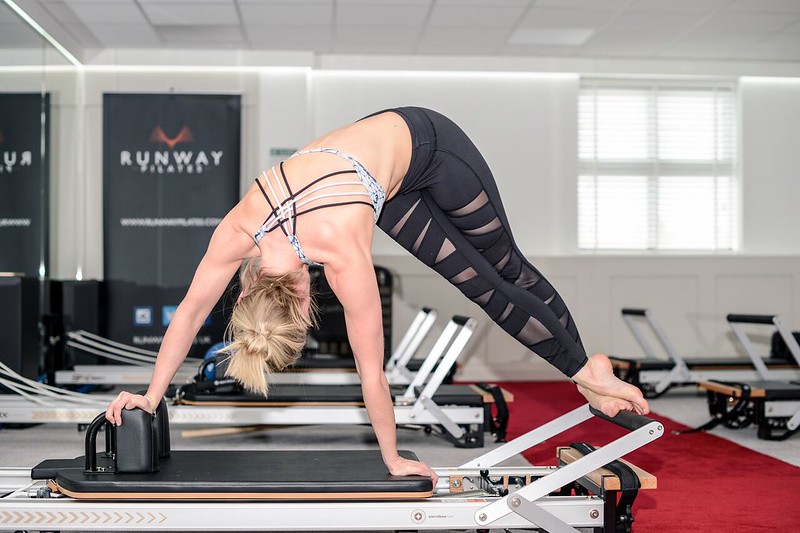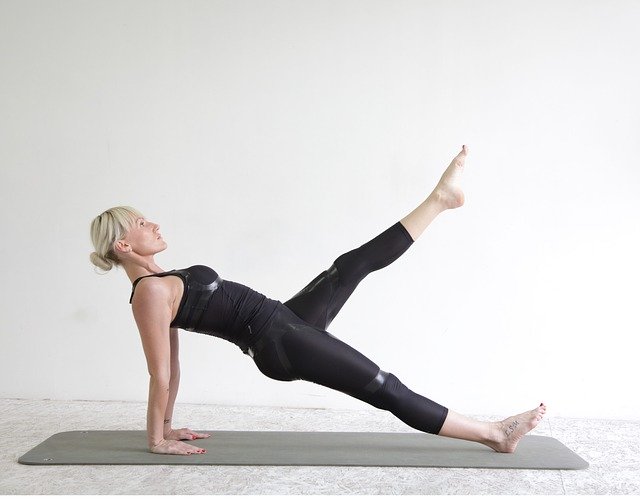If you’re ready to finally (seriously this time) get into better shape, you might be considering pilates as your workout of choice.
The best part is you don’t even need to sign up for a class! You can buy your own mat and find some videos online guiding you through each exercise, though of course the studio workouts are fantastic, as well.
It’s a lot of fun, and it’s a fairly low-impact workout, so it’s a lot less intimidating than trying to get into weights or running.
But what kind of results can you expect to see after one month (or about 20 to 30 sessions) of pilates? Will you lose weight? Develop a more defined core? Build up leg or arm muscles?
What will your pilates before and after transformation look like after 1 months? 3 months?

During your first month of pilates, you should expect a greater sense of comfort and mobility in your body. These moves aren’t necessarily calorie burners, but combined with a healthy diet, you can definitely expect to see some improvements in your overall health.
Pilates, unbeknownst to a lot of people, is actually more of a strength workout! So you’ll definitely feel stronger and notice better muscle tone.
More than anything, you can expect greater flexibility — especially after regular reformer pilates classes. A major goal of pilates is to elongate the spine and develop a greater sense of balance. You won’t get a six-pack, but you may find that it’s much easier to touch your toes and reach items on the top shelf.
Your body and mood will continue to improve over time.
I spoke with several people associated with pilates studios to gain a better understanding of what you can expect one month after starting these workouts. As long as you’re committed, you can expect to see plenty of progress within those first 30 days.
Weight Loss
Pilates (both on the mat and reformer machine) is a great way to tone up certain areas on your body, such as your stomach and glutes.
(A LOT of people turn to pilates for stomach help! Though diet is the primary driver of weight loss, lots of pilates core work can help strength and improve the appearance of your midsection.)
If your primary workout goal is weight loss, then pilates definitely burns calories. However, you won’t see the same kind of burn you can expect with other cardio exercises like running.
While the exact amount of burned calories will vary from one person to the next, Healthline reports that a 150-pound individual can expect to burn about 175 calories from 50 minutes of practicing pilates.
Compare that to running where a 150-pound person can burn over 400 calories after 50 minutes of exercise.
And of course, you won’t really see any weight loss if you don’t change your diet. You need to create a calorie deficit as opposed to a calorie surplus.
Doing pilates three or four times a week is great, but you also need to become more mindful of what you’re eating throughout any given day.
Molly Niles Renshaw, co-owner of Phoenix Classical Pilates confirmed as much:
“As one advances and your transitions from exercise to exercise gets seamless, the workout will become more aerobic, more like cardio. In the beginning though, you will feel your body changing but without watching your diet pretty strictly you may not lose any weight.”
If weight loss is your goal, it can be a good idea to supplement your pilates sessions with other workouts to burn extra calories. For instance, you can spend 30 minutes practicing pilates and then an additional 30 minutes jogging on the treadmill.
That way you’re focusing both on stretching muscles and burning calories.
Soreness
Pilates is a great way to work out almost every muscle in your body.
However, if you are new to the exercise game, then you should anticipate some soreness later in the day after your workout.
When you first begin a new workout, your muscle fibers experience microscopic damage, according to Livestrong.
But relax! This is actually a good thing.
When your muscles repair themselves, you will become stronger. That initial soreness gives way to greater strength in the long run.
Renshaw brought up another good point. There are different types of beginners when it comes to pilates. You can have people starting an exercise regimen for the first time and someone who’s experienced with other exercises but wants to give pilates a go.
She writes, “In the first month, the beginner Grandma will definitely feel different – simple stuff – she might be able to tie her shoes with ease for the first time in years or be able to bend down and pick up her grandson. Simple but powerful.
The marathoner might feel more flexibility in their quads, hamstrings and calves.”
A little soreness is to be expected with any new exercise, especially during the first 30 days. Throughout this time, you just have to be careful not to overexert yourself.
And remember, it’s a good idea to start off slow.
Should you do pilates every day for the best results? Probably not.
Perhaps you’ll only practice pilates three days a week to start. As you grow more comfortable with the regimen, you can start doing it more often.
Even then, including a couple of rest days every week will get you the best pilates before and after transformation you’re looking for.
Endurance
Many people may associate endurance with intense cardiovascular exercises.
However, even if you prefer running, you can still reap numerous benefits by incorporating pilates into your routine.
Through pilates, you can enhance muscular endurance by improving posture, joint movement, and balance. All of these advantages will assist you as you pursue other exercises.
“A side benefit of Pilates is a greater feeling of energy because Pilates delivers more oxygen to the body,” writes Susannah Cotrone, co-owner of Cotrone Pilates.
She adds that as your mobility improves, you’ll become game for more and more activity in your daily life.
When you have greater mobility, you can stretch your legs more. You can move them more often, so you have a reduced risk of sustaining an injury over the course of your other workouts.
Even in the first 30 days (or 20 to 30 pilates sessions or so — around 1 month of pilates classes), you’ll build up muscles in your legs, hips, and back. Over time, you’ll find that your running stride is stronger and more fluid.
But this is a benefit that takes time to develop. You need to establish the groundwork in the first month so that you set yourself up for success later.
Muscle & Strength

Pilates is a great way to build lean, functional muscle.
That’s because you’re using your own body weight in lieu of dumbbells to build up your arms and legs.
However, don’t expect any major transformations within the first 30 days. You won’t get a six-pack or huge biceps.
If anything, you’ll quickly find that your muscles have become functionally stronger and more toned (especially if you watch your diet and lose weight the first month), and it’s a lot easier to bend down after just a handful of lessons or classes.
Pilates an excellent form of strength training that does not require a great deal of expensive equipment, however, you won’t get tree trunk legs, huge shoulders, or bulging pecs if that’s what you’re going for.
Instead, you’ll notice a sleeker, more defined and athletic body.
A lot of pilates courses have a major emphasis on core/abs and booty, if that’s your thing. You’ll be shocked at how hard and effective these small, pulsing movements can really be.
Mind & Mood
Finally, pilates is fantastic for improving your mental health.
Your pilates before and after won’t be purely physical. You may see a serious transformation within your own brain!
There’s always a certain sense of accomplishment when trying something new for the first time and sticking with it. But pilates goes well beyond that.
It’s been found that regularly practicing pilates can help with your:
- Concentration
- Breathing
- Motivation
Pilates has also been found to be a great exercise for those with anxiety. The reason for this is that this exercise increases your bodily energy, relaxes your muscles, improves blood circulation, and enhances your sleep quality.
You should start seeing some of these develop within the first month, so continue with your regimen, even if you start feeling busy with everything else in your life.
Hector Mercado, another co-owner of Phoenix Classical Pilates, brought up a great point from the founder of the art of pilates, Joseph Pilates.
In regards to when people will notice an improvement in mood, Hector wrote, “Joseph Pilates said in the first 10 lessons you will feel the difference and in the next 10 you will see the difference and in the next 10 people will notice the difference. I found those numbers to be very accurate.”
Your health requires a multi-pronged approach. Doing pilates a few times a week but continuing to eat unhealthy meals will mean you won’t really see any improvements.
However, if you commit to pilates, eat right (or at least better!), and make other healthy choices in your day-to-day life, then you will be amazed at what you can accomplish in just 30 days.
Wrapping Up
Pilates is great exercise choice, especially for people who want something more easygoing.
But you need to have realistic goals before going into it wholeheartedly.
So how long until you’ll see results from mat or reformer?
If you start practicing pilates a few times each week, then after the first 30 days or one month, you’ll notice a marked improvement in your posture, balance, and flexibility. You should start having more energy, and you may notice your muscles look a little leaner and more toned.
You’ll likely be quite sore after your first handful of sessions, and don’t expect any dramatic transformations right away — pilates won’t make you “jacked” and you won’t lose a lot of weight without getting serious about your diet.
What did we miss? What’s your favorite thing about pilates and what should beginners expect?
Before you go, check out some tips for your first pilates class.
If it sounds like pilates isn’t for you, you might like these guides to your first month of running, lifting weights, Callanetics, or even CrossFit!